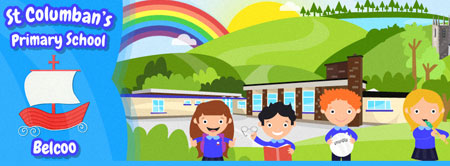- Home
- Curriculum
- Cross-Curricular Skills
- Communication
Communication
Communication is central to the whole curriculum at St Columban's PS. Pupils should be able to communicate in order to develop as individuals, to express themselves socially, emotionally and physically, to engage with others and to contribute as members of society.
However, effective communication also includes non-verbal modes of communication, wider literacy and the use of multimedia and ICT technologies which may combine different modes. Pupils are therefore encouraged to become effective communicators by using a range of techniques, forms and media to convey information and ideas creatively and appropriately.
Communication encompasses the skills of Talking and Listening, Reading and Writing in a range of contexts across the curriculum. Standards of pupil competency in Language and Literacy are measured through the cross-curricular skill of Communication.
Across the curriculum, at a level appropriate to their ability, pupils have the opportunity to develop skills in the following areas;
Talking and Listening – this includes having opportunities to:
-
listen to and take part in discussions, explanations, role plays and presentations;
-
contribute comments, ask questions and respond to others' points of view;
-
communicate information, ideas, opinions, feelings and imaginings, using an expanding vocabulary;
-
structure talk so that ideas can be understood by others;
-
speak clearly and adapt ways of speaking to audience and situation;
-
use non-verbal methods to express ideas and engage with the listener.
Reading – this includes having opportunities to:
-
read a range of texts* for information, ideas and enjoyment;
-
use a range of strategies to read with increasing independence;
-
find, select and use information from a range of sources;
-
understand and explore ideas, events and features in texts*;
-
use evidence from texts* to explain opinions.
* Texts refer to ideas that are organised to communicate and present a message in written, spoken, visual and symbolic forms.
Writing – this includes having opportunities to:
-
talk about, plan and edit work;
-
communicate information, meaning, feelings, imaginings and ideas in a clear and organised way;
-
develop, express and present ideas in a variety of forms and formats, using traditional and digital resources, for different audiences and purposes;
-
write with increasing accuracy and proficiency.
St Columban's Primary School Belcoo, Enniskillen BT93 5DS | Phone: 028 66 386286
 Menu
Menu

